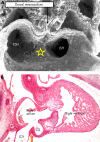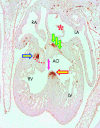Development of the heart: (2) Septation of the atriums and ventricles
- PMID: 12860885
- PMCID: PMC1767797
- DOI: 10.1136/heart.89.8.949
Development of the heart: (2) Septation of the atriums and ventricles
Figures




















References
-
- Moorman AFM, Webb S, Brown NA, et al. The development of the heart: (1) Formation of the cardiac chambers and arterial trunks. Heart 2003;89:806–14. ▸ In this, the first of our reviews, we discussed the steps involved in formation of the heart tube and the components of the cardiac chambers and arterial trunks. - PMC - PubMed
-
- Larsen WJ. Human embryology. New York: Churchill Livingstone 1993;147. ▸ This otherwise excellent student textbook of embryology used the “classical” account for development of the atrial septum, with purported primary and secondary septums illustrated as overlapping sheets that have grown into the heart.
-
- Anderson RH, Brown NA. The anatomy of the heart revisited. Anat Rec 1996;62:710–16. ▸ The review in which we questioned the definition of septal structures, arguing that it should be possible to resect a “true” septum without exiting from the cavities of the heart.
-
- Becker AE, Anderson RH. Atrioventricular septal defects. What’s in a name? J Thorac Cardiovasc Surg 1982;83:461–9. ▸ This review has proved seminal in the classification of hearts with common atrioventricular junction. In retrospect, however, we were wrong when we argued that, in addition to the fibrous atrioventricular septum, there was also a muscular septum. We now know that the purported muscular septum is, in reality, a layer of extracardiac fibroadipose tissue sandwiched between the atrial and ventricular walls. - PubMed
-
- Webb S, Kanani M, Anderson RH, et al. Development of the human pulmonary vein and its incorporation in the morphologically left atrium. Cardiol Young 2001;11:632–42. ▸ In this study, we showed how the pulmonary vein canalised as a new structure in the medistinal tissues, using the dorsal mesocardium to gain entrance to the primary atrial compartment of the heart tube. Only much later are the walls of the separate veins incorporated to form the dome of the left atrium. - PubMed
Publication types
MeSH terms
LinkOut - more resources
Full Text Sources
